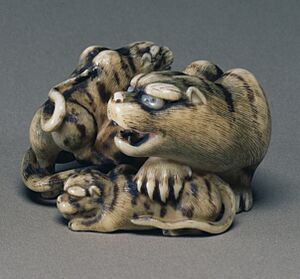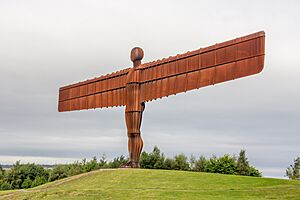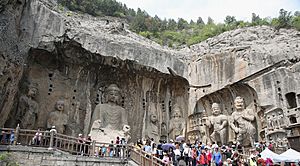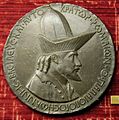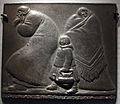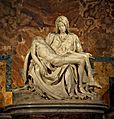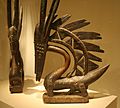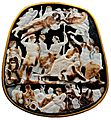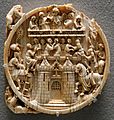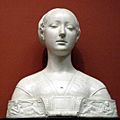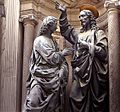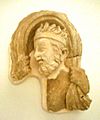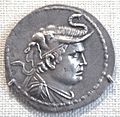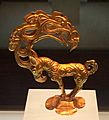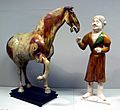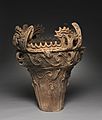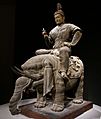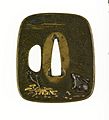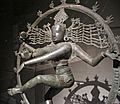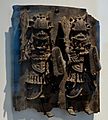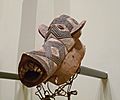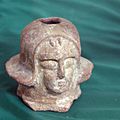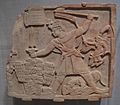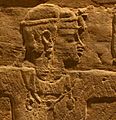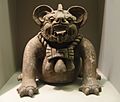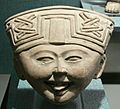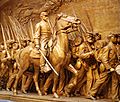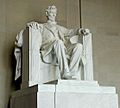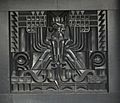Sculpture facts for kids
Sculpture is a type of art that creates objects in three dimensions. It's one of the oldest forms of art. Early sculptors used methods like carving (removing material) and modeling (adding material, like clay). They worked with stone, metal, ceramics, wood, and other materials. Today, artists have much more freedom with materials and methods. They can carve, assemble pieces by welding, or use molding and casting techniques.
Sculptures made from stone last a very long time. This is why many ancient sculptures from old cultures are still around today. However, most ancient sculptures were once painted in bright colors, but these colors have faded away over time.
For many cultures, sculpture was very important for religious purposes. Until recently, large sculptures were very expensive to make. They were usually created to show religious beliefs or political power. Many sculptures have survived from ancient cultures in the Mediterranean, India, China, Central and South America, and Africa.
The Western tradition of sculpture started in ancient Greece. Greece is famous for its amazing sculptures from the classical period. During the Middle Ages, Gothic sculptures showed the strong feelings of the Christian faith. Later, during the Renaissance, artists looked back at classical styles. This led to famous works like Michelangelo's David. Modern sculpture moved away from old methods and focusing on the human body. Artists started making constructed sculptures and showing everyday objects as art.
Exploring Different Types of Sculpture
There are two main types of sculpture. One is called "sculpture in the round." These are free-standing statues that are not attached to a background, except maybe at the bottom. The other type is relief sculpture. These are partly attached to a flat surface.
Relief sculptures are often grouped by how much they stick out from the wall:
- Low relief (or bas-relief) sticks out only a little.
- High relief sticks out a lot.
- Sometimes there's a mid-relief in between.
- Sunk-relief is a special technique only used in ancient Egypt.
Relief is often used for large groups of figures or to tell a story. It's also common for architectural sculpture (sculpture attached to buildings) and for decorating smaller items like pottery, metalwork, and jewellery. Relief sculptures can also be found on steles, which are upright stone slabs that often have writings on them.
Another way to tell sculptures apart is by how they are made.
- Subtractive carving means removing material from a block, like stone or wood.
- Modelling means shaping or building up the work from a material.
- Techniques like casting, stamping, and molding use a special form (a matrix) to create the design. These methods allow artists to make many copies of a sculpture.
The word "sculpture" often makes us think of big artworks. These are sometimes called "monumental sculptures." This can mean they are very large or that they are part of a building. But sculpture also includes many smaller three-dimensional works. This includes coins, medals, and hardstone carvings, which are small, detailed carvings in stone.
Very large or "colossal" statues have always been popular since ancient times. The biggest one ever recorded is the Statue of Unity in India, which is 182 meters (597 feet) tall. Another grand type of sculpture is the equestrian statue, which shows a rider on a horse. These are not as common today.
Smaller types of portrait sculpture include:
- A "head," which shows only the head.
- A bust, which shows a person from the chest up.
Even smaller sculptures include:
- The figurine, which is usually a statue less than 18 inches (46 cm) tall.
- For reliefs, there are plaquettes, medals, or coins.
Modern and contemporary art have brought in many new forms of sculpture. These include sound sculpture, light sculpture, environmental art, environmental sculpture, street art sculpture, and kinetic sculpture (which involves physical motion). There's also land art and site-specific art, which are made for a particular place. Sculpture is an important part of public art, which is art displayed in public spaces. A collection of sculptures in a garden is called a sculpture garden.
Related pages
Images for kids
-
Moai from Easter Island, where the concentration of resources on large sculpture may have had serious political effects.
-
Medal of John VIII Palaeologus, c. 1435, by Pisanello, the first portrait medal, a medium essentially made for collecting.
-
Sumerian male worshipper, alabaster with shell eyes, 2750−2600 BCE
-
Dale Chihuly, 2006, (Blown glass)
-
A carved wooden Bodhisattva from China's Song dynasty 960–1279, Shanghai Museum
-
Nuremberg sculptor Adam Kraft, self-portrait from St Lorenz Church, 1490s.
-
Venus of Hohle Fels (also known as the Venus of Schelklingen; is an Upper Paleolithic Venus figurine hewn from ivory of a mammoth tusk found in 2008 near Schelklingen, Germany. It is dated to between 35,000 and 40,000 years ago, belonging to the early Aurignacian, at the very beginning of the Upper Paleolithic, which is associated with the assumed earliest presence of Homo sapiens in Europe (Cro-Magnon). Along with the Löwenmensch, it is the oldest undisputed example of Upper Paleolithic art and figurative prehistoric art in general.
-
Cylinder seal with its impression on clay; serpopards and eagles, Uruk Period, 4100–3000 BCE
-
Thutmose, Bust of Nefertiti, 1345 BCE, Egyptian Museum of Berlin
-
Charioteer of Delphi, ancient Greek bronze sculpture, 5th century BCE, close up head detail
-
Section of Trajan's Column, CE 113, with scenes from the Dacian Wars
-
Silver monster on a chape, Scottish or Anglo-Saxon, St Ninian's Isle Treasure, c. 800?
-
Michelangelo, Pietà, 1499
-
Seated Bodhisattva Guanyin, wood and pigment, 11th century, Northern Song dynasty.
-
9th-century Khmer lintel
-
Mask from Gabon
-
Two Chiwara c. late 19th early 20th centuries, Art Institute of Chicago. Female (left) and male Vertical styles
-
St. James panel, from reredos in Cristo Rey Church, Santa Fe, New Mexico, c. 1760
-
Edgar Degas, Little Dancer of Fourteen Years, cast in 1922 from a mixed-media sculpture modeled c. 1879–80, Bronze, partly tinted, with cotton
-
Henry Moore, Large Reclining Figure, 1984 (based on a smaller model of 1938), Fitzwilliam Museum, Cambridge
-
David Smith, CUBI VI, (1963), Israel Museum, Jerusalem.
-
Christo and Jeanne-Claude, Umbrellas 1991, Japan
-
Device to Root Out Evil (1997) sculpture by Dennis Oppenheim at Palma de Mallorca, Plaça de la Porta de Santa Catalina
-
Spiral Jetty by Robert Smithson, in 2005
-
Visible damage due to acid rain on a sculpture
-
Löwenmensch, from Hohlenstein-Stadel, now in Ulmer Museum, Ulm, Germany, the oldest known anthropomorphic animal-human statuette, Aurignacian era, c. 35–40,000 BP
-
Creeping Hyena, c. 12–17,000 BP, mammoth ivory, found in La Madeleine, France
-
The Guennol Lioness, 3rd millennium BCE, 3.25 cm high
-
Part of the Lion Hunt of Ashurbanipal, c. 640 BCE, Nineveh
-
Facsimile of the Narmer Palette, c. 3100 BCE, which already shows the canonical Egyptian profile view and proportions of the figure
-
Menkaura (Mycerinus) and queen, Old Kingdom, Dynasty 4, 2490–2472 BCE. The formality of the pose is reduced by the queen's arm round her husband
-
Tutankhamun's mask, c. late Eighteenth dynasty, Egyptian Museum
-
The Younger Memnon c. 1250 BCE, British Museum
-
Osiris on a lapis lazuli pillar in the middle, flanked by Horus on the left, and Isis on the right, 22nd dynasty, Louvre
-
The ka statue provided a physical place for the ka to manifest. Egyptian Museum, Cairo
-
Block statue of Pa-Ankh-Ra, ship master, bearing a statue of Ptah. Late Period, c. 650–633 BCE, Cabinet des Médailles
-
Peplos Kore, c. 530 BCE, Athens, Acropolis Museum
-
The Amathus sarcophagus, from Amathus, Cyprus, 2nd quarter of the 5th century BCE Archaic period, Metropolitan Museum of Art
-
Bronze Statuette of a Horse, late 2nd – 1st century BCE Metropolitan Museum of Art
-
The Winged Victory of Samothrace, c. 190 BCE, Louvre
-
Etruscan sarcophagus, 3rd century BCE
-
Augustus of Prima Porta, statue of the emperor Augustus, 1st century CE. Vatican Museums
-
Bust of Emperor Claudius, c. 50 CE, (reworked from a bust of emperor Caligula), It was found in the so-called Otricoli basilica in Lanuvium, Italy, Vatican Museums
-
The Four Tetrarchs, c. 305, showing the new anti-classical style, in porphyry, now San Marco, Venice
-
Archangel Ivory, 525–550, Constantinople
-
Late Carolingian ivory panel, probably meant for a book-cover
-
The Harbaville Triptych, Byzantine ivory, mid-10th century
-
The tympanum of Vézelay Abbey, Burgundy, France, 1130s
-
Facade, Cathedral of Ourense 1160, Spain
-
Pórtico da Gloria, Cathedral of Santiago de Compostela, Galicia, Spain, c. 12th–13th centuries
-
West portal of Chartres Cathedral (c. 1145)
-
South portal of Chartres Cathedral (c. 1215–1220)
-
West portal at Reims Cathedral, Annunciation group
-
Nicola Pisano, Nativity and Adoration of the Magi from the pulpit of the Pisa Baptistery
-
Lid of the Walters Casket, with the Siege of the Castle of Love at left, and jousting. Paris, 1330–1350
-
Siege of the Castle of Love on a mirror-case in the Louvre, 1350–1370; the ladies are losing.
-
Central German Pietà, 1330–1340
-
Claus Sluter, David and a prophet from the Well of Moses
-
Section of a panelled altarpiece with Resurrection of Christ, English, 1450–1490, Nottingham alabaster with remains of colour
-
Detail of the Last Supper from Tilman Riemenschneider's Altar of the Holy Blood, 1501–1505, Rothenburg ob der Tauber, Bavaria
-
Luca della Robbia, detail of Cantoria, c. 1438, Museo dell'Opera del Duomo, Florence
-
Francesco Laurana, female bust (cast)
-
Verrocchio, Doubting Thomas, 1467–1483, Orsanmichele, Florence
-
Giambologna, Samson Slaying a Philistine, about 1562
-
Bust of Louis XIV, 1686, by Antoine Coysevox
-
Saint Veronica by Francesco Mochi (1640), Saint Peter's Basilica
-
Franz Anton Bustelli, Rococo Nymphenburg Porcelain group
-
Jean-Antoine Houdon, Bust of Benjamin Franklin, 1778, Metropolitan Museum of Art
-
John Flaxman, Memorial in the church at Badger, Shropshire, c. 1780s
-
Gandhara frieze with devotees, holding plantain leaves, in purely Hellenistic style, inside Corinthian columns, 1st–2nd century CE. Buner, Swat, Pakistan. Victoria and Albert Museum
-
Fragment of the wind god Boreas, Hadda, Afghanistan.
-
Stucco Buddha head, once painted, from Hadda, Afghanistan, 3rd–4th centuries
-
Gandhara Poseidon (Ancient Orient Museum)
-
The Buddhist gods Pancika (left) and Hariti (right), 3rd century, Gandhara
-
Taller Buddha of Bamiyan, c. 547 CE, in 1963 and in 2008 after they were dynamited and destroyed in March 2001 by the Taliban
-
A bronze ding from late Shang dynasty (13th century–10th century BCE)
-
A tomb guardian usually placed inside the doors of the tomb to protect or guide the soul, Warring States period, c. 3rd century BCE
-
Lifesize calvalryman from the Terracotta Army, Qin dynasty, c. 3rd century BCE
-
Gold stag with eagle's head, and ten further heads in the antlers. An object inspired by the art of the Siberian Altai mountain, possibly Pazyryk, unearthed at the site of Nalinggaotu, Shenmu County, near Xi'an, China. Possibly from the "Hun people who lived in the prairie in Northern China". Dated to the 4th-3rd century BCE, or Han Dynasty period. Shaanxi History Museum.
-
Tomb figure of dancing girl, Han Dynasty (202 BCE—220 CE)
-
Bronze cowrie container with yaks, from the Dian Kingdom (4th century BCE – 109 BCE) tradition of the Western Han
-
Northern Wei dynasty Maitreya (386–534)
-
Seated Buddha, Tang dynasty c. 650.
-
The Leshan Giant Buddha, Tang dynasty, completed in 803.
-
A wooden Bodhisattva from the Song dynasty (960–1279)
-
Chinese jade Cup with Dragon Handles, Song dynasty, 12th century
-
Guanyin Bodhisattva in Blanc de Chine (Dehua porcelain), by He Chaozong, Ming dynasty, early 17th century
-
Blue underglaze statue of a man with his pipe, Jingdezhen porcelain, Ming Wanli period (1573–1620)
-
A Chinese guardian lion outside Yonghe Temple, Beijing, Qing dynasty, c. 1694
-
'Flame-style' vessel, Neolithic Jōmon period; c. 2750 BCE; earthenware with carved and applied decoration; height: 61 cm, diameter: 55.8 cm
-
Dogū with "snow-goggle" eyes, 1000–400 BCE
-
6th-century haniwa figure
-
Kongo Rishiki (Guardian Deity) at the Central Gate of Hōryū-ji
-
Priest Ganjin (Jianzhen), Nara period, 8th century
-
Taishakuten Śakra, 839, Tō-ji
-
Izumiya Tomotada, netsuke in the form of a dog, late 18th century
-
Eagle by Suzuki Chokichi, 1892, Tokyo National Museum
-
The "Dancing Girl" of Mohenjo-daro, 3rd or 2nd millennium BCE (replica)
-
Stupa gateway at Sanchi, c. 100 CE or perhaps earlier, with densely packed reliefs
-
Buddha from Sarnath, 5th–6th century CE
-
The Colossal trimurti at the Elephanta Caves
-
Rock-cut temples at Ellora
-
Jain shrine with Rishabhanatha, Parshvanatha, Neminatha, and Mahavira, 6th century
-
Hindu, Chola period, 1000
-
Typical medieval frontal standing statue of Vishnu, 950–1150
-
Marble Sculpture of female yakshi in typical curving pose, c. 1450, Rajasthan
-
Gopuram of the Thillai Nataraja Temple, Chidambaram, Tamil Nadu, densely packed with rows of painted statues
-
Bronze Avalokiteshvara from Bidor, Perak, Malaysia, c. 8th-9th century
-
Head of Jayavarman VII, Khmer art, Cambodia, c. late 12th century
-
Buddha in Ananda Temple, Bagan, Myanmar, c. 1105
-
Prajnaparamita Singhasari art, East Java, Indonesia, c. 13th century
-
"the Buddha calling the earth to witness", The Buddha's hands are in the bhūmisparsa mudrā (subduing Māra) position. Ho Phra Kaeo temple, Vientiane, Laos
-
The Mshatta Facade, from a palace near Damascus, 740s
-
The Pisa Griffin, 107 cm high, probably 11th century
-
Mughal dagger with hilt in jade, gold, rubies and emeralds. Blade of damascened steel inlaid with gold.
-
Nok terracotta, 6th century BCE–6th century CE
-
Ife head, terracotta, probably 12–14th centuries CE
-
Yoruba bronze head sculpture, Ife, Nigeria c. 12th century
-
One of the Benin Bronzes, 16th–18th century, Nigeria.
-
Mask from Burkina Faso, 19th century
-
A jar spout from the early Kingdom of Aksum
-
A processional cross, Zagwe dynasty, 12th century
-
One of the seven life-size saints carved into the wall of the Church of Bet Golgotha, Lalibela, 15th century (traditionally believed to have been made during the reign of Gebre Mesqel Lalibela)
-
A ceramic jug of the Kerma culture
-
A shabti of the Nubian King Taharqa, from a pyramid of Nuri, Sudan, Twenty-fifth Dynasty of Egypt, 690–664 BCE
-
Traces of paint on a relief depicting Prince Arikhankharer smiting his enemies, from the Meroitic period of the Kingdom of Kush, early 1st century CE
-
Relief of a ruler, a Candace of Meroë named Kandake Amanitore, 1st century CE
-
Olmec Baby Figure 1200-900 BCE
-
Olmec Colossal Head No. 3 1200–900 BCE
-
La Mojarra Stela 1 2nd century CE
-
Teotihuacan mask 200–600 CE
-
A funerary urn in the shape of a "bat god" or a jaguar, Oaxaca, 300–650 CE
-
Moche portrait vessel with stirrup spout, Peru, 100 BCE–700 CE
-
K'inich Janaab Pakal I of Palenque, Maya, 603–683 CE
-
Jaina Island type figure (Mayan) 650–800 CE
-
Classic Veracruz culture face 600–900 CE
-
Atlante from Tula, c. 1000 CE
-
Double-headed serpent, Turquoise, red and white mosaic on wood, Aztec (possibly) Mixtec, c. 1400–1521,
-
Gutzon Borglum and his son, Lincoln Borglum, Mount Rushmore, 1927–1941. L–R, George Washington, Thomas Jefferson, Theodore Roosevelt, and Abraham Lincoln.
-
Robert Gould Shaw Memorial by Augustus Saint-Gaudens, 1884–1897, plaster version
-
Lee Lawrie, The Sower, 1928 Art Deco relief on Beaumont Tower, Michigan State University
-
Daniel Chester French, Abraham Lincoln (1920) in the Lincoln Memorial, Washington, D.C.
-
The K'alyaan Totem Pole of the Tlingit Kiks.ádi Clan, erected at Sitka National Historical Park to commemorate the lives lost in the 1804 Battle of Sitka
-
Frederic Remington, The Bronco Buster, 1895, cast 1918. Metropolitan Museum of Art
-
Gertrude Vanderbilt Whitney, Buffalo Bill - The Scout, 1924, commemorating Buffalo Bill in Cody, Wyoming
-
Amedeo Modigliani, Female Head, 1911–12, Metropolitan Museum of Art
-
Constantin Brâncuși, Portrait of Mademoiselle Pogany, 1912, white marble; limestone block, Philadelphia Museum of Art. Exhibited at the 1913 Armory Show
-
Marcel Duchamp, Fountain, 1917
-
Jacob Epstein, Day and Night, carved for the London Underground's headquarters, 1928.
-
Mieczysław Kotarbiński, Coat of arms of Poland, basalt relief in Art Deco style, Warsaw, 1931.
-
Käthe Kollwitz, The Grieving Parents, 1932, World War I memorial (for her son Peter), Vladslo German war cemetery
-
Jacques Lipchitz, Birth of the Muses, 1944–1950
-
Barbara Hepworth, Monolith-Empyrean, 1953
-
John Chamberlain, S, 1959, Hirshhorn Museum and Sculpture Garden, Washington, DC.
-
Henry Moore, Three Piece Reclining figure No.1, 1961, Yorkshire
-
Pablo Picasso, Chicago Picasso, 1967, Chicago, Illinois
-
George Rickey, Four Squares in Geviert, 1969, terrace of the New National Gallery, Berlin, Germany, Rickey is considered a Kinetic sculptor
-
Alexander Calder, Crinkly avec disc rouge, 1973, Schlossplatz, Stuttgart
-
Louise Nevelson, Atmosphere and Environment XII, 1970–1973, Philadelphia Museum of Art
-
Sir Anthony Caro, Black Cover Flat, 1974, steel, Tel Aviv Museum of Art
-
Joan Miró, Woman and Bird, 1982, Barcelona, Spain
-
Louise Bourgeois, Maman, 1999, outside Museo Guggenheim
-
Tony Smith, Free Ride, 1962, 6'8 x 6'8 x 6'8 (the height of a standard US door opening), Museum of Modern Art, New York
-
Larry Bell, Untitled 1964, bismuth, chromium, gold, and rhodium on gold-plated brass; Hirshhorn Museum and Sculpture Garden
-
Donald Judd, Untitled 1977, Münster, Germany
-
Richard Serra, Fulcrum 1987, 55 ft high free standing sculpture of Cor-ten steel near Liverpool Street station, London
-
Donald Judd, Untitled, 1991, Israel Museum Art Garden, Jerusalem
-
Richard Long, South Bank Circle, 1991 Tate Liverpool, England
-
Anish Kapoor, Turning the World Upside Down, Israel Museum, 2010
-
Rachel Whiteread, Judenplatz Holocaust Memorial, Vienna, 2000
-
Guardians of Time, light sculpture by Manfred Kielnhofer at the Light Art Biennale Austria 2010
-
The Spire of Dublin officially titled the Monument of Light, stainless steel, 121.2 m, the world's tallest sculpture
See also
 In Spanish: Escultura para niños
In Spanish: Escultura para niños




